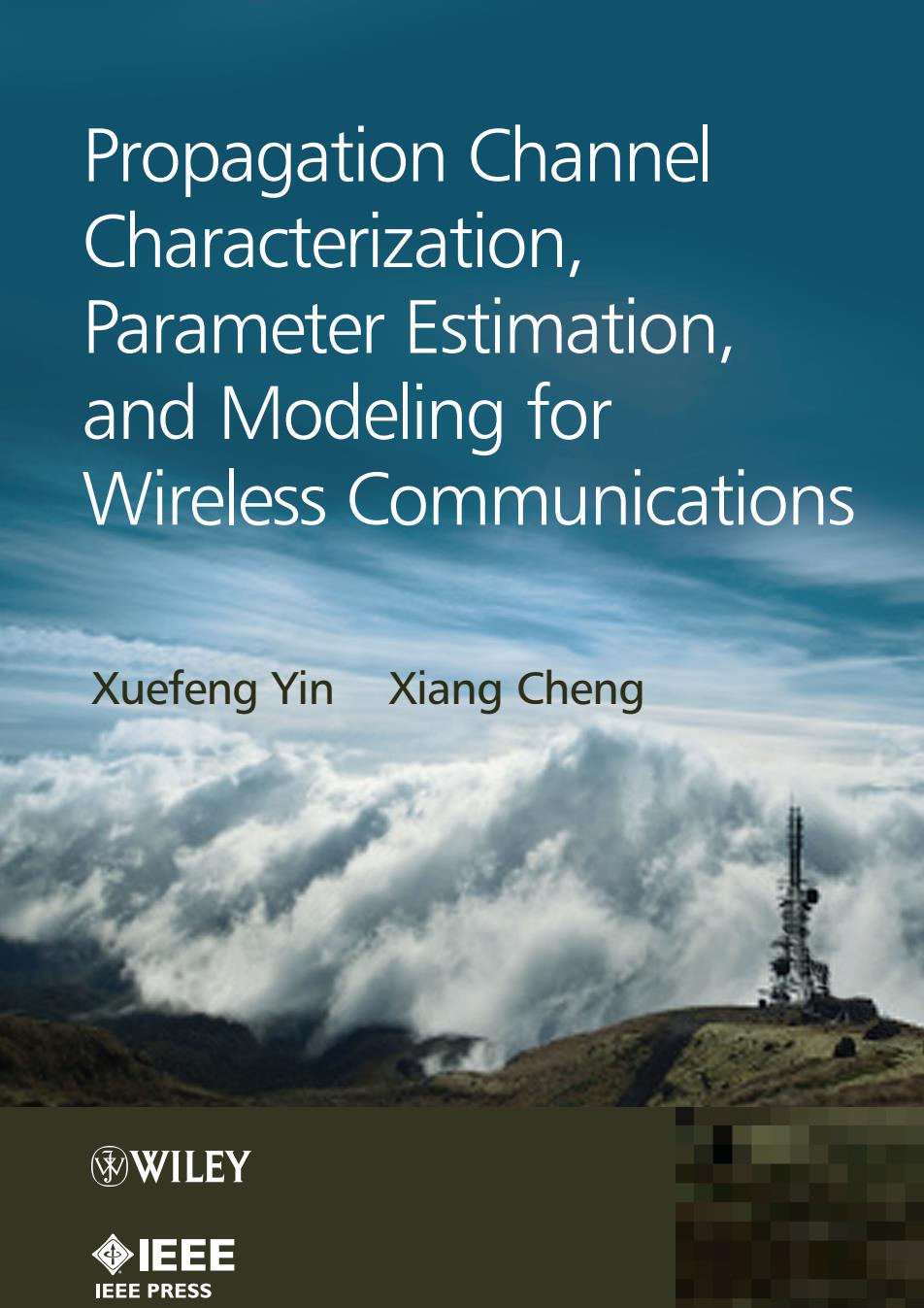
Propagation Channel Characterization, Parameter Estimation, and Modeling for Wireless Communications Xuefeng Yin Xiang Cheng ③WILEY ④EEE IEEE PRESS
Xuefeng Yin Xiang Cheng Propagation Channel Characterization, Parameter Estimation, and Modeling for Wireless Communications
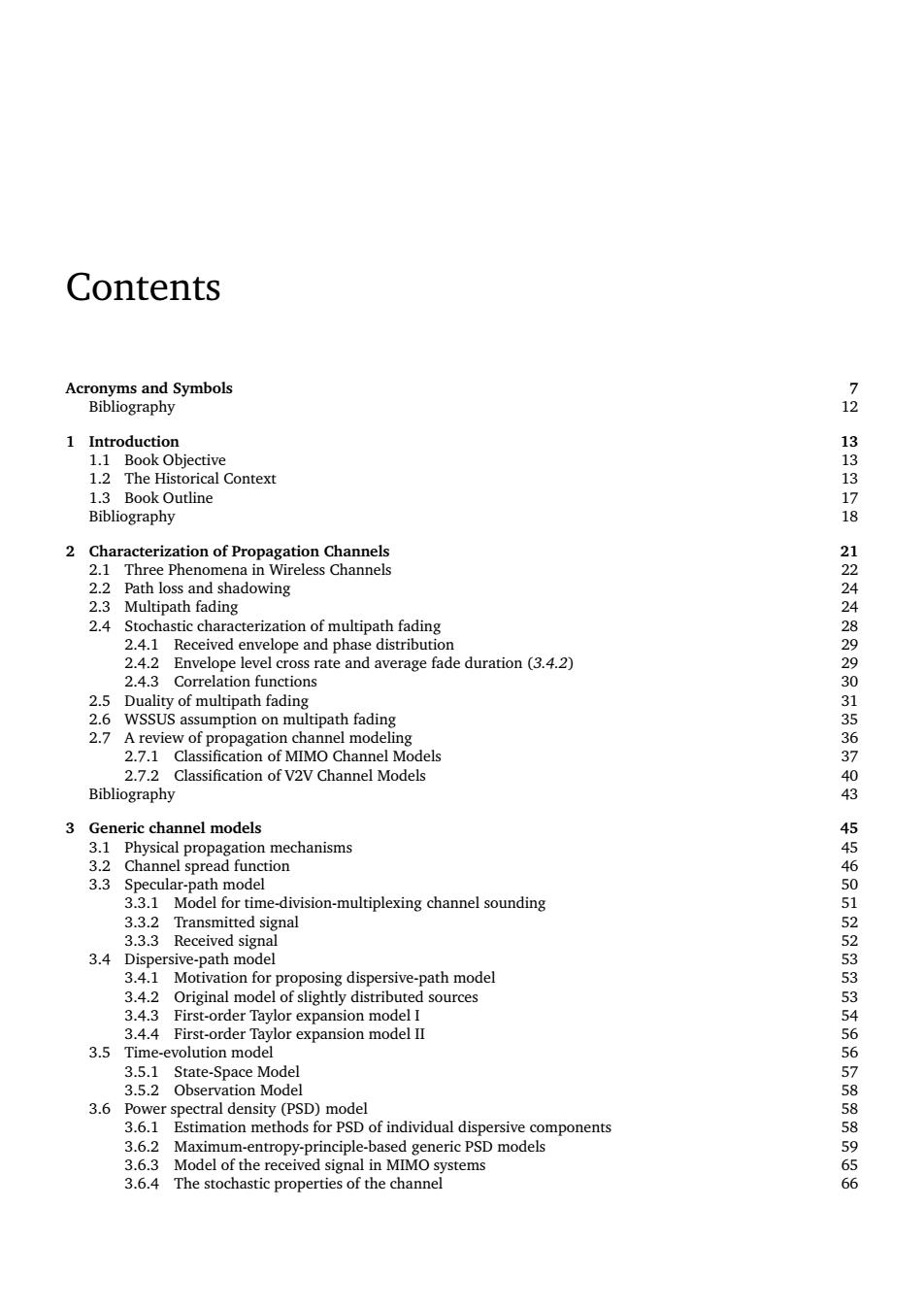
Contents 13131378 2 duration(3.4.2) 243 2.7.1 Classification of MIMO Channel Models 1244899035670 Classification of V2V Channel Models Bibli e 3 Model for time-division-multiplexn channel sounding 3.3.2 Transmitted signal 3.3.3 Receive 34 3.Movation for dispersive-path mode 343 model of sih y distribu ed sources 3.5 352 3.6 Power spectral density(D)mode 444650522333346678889666 3.6.2 Maximum-entrop 364 Model of the received signal The stochastic properties
Contents Acronyms and Symbols 7 Bibliography 12 1 Introduction 13 1.1 Book Objective 13 1.2 The Historical Context 13 1.3 Book Outline 17 Bibliography 18 2 Characterization of Propagation Channels 21 2.1 Three Phenomena in Wireless Channels 22 2.2 Path loss and shadowing 24 2.3 Multipath fading 24 2.4 Stochastic characterization of multipath fading 28 2.4.1 Received envelope and phase distribution 29 2.4.2 Envelope level cross rate and average fade duration (3.4.2) 29 2.4.3 Correlation functions 30 2.5 Duality of multipath fading 31 2.6 WSSUS assumption on multipath fading 35 2.7 A review of propagation channel modeling 36 2.7.1 Classification of MIMO Channel Models 37 2.7.2 Classification of V2V Channel Models 40 Bibliography 43 3 Generic channel models 45 3.1 Physical propagation mechanisms 45 3.2 Channel spread function 46 3.3 Specular-path model 50 3.3.1 Model for time-division-multiplexing channel sounding 51 3.3.2 Transmitted signal 52 3.3.3 Received signal 52 3.4 Dispersive-path model 53 3.4.1 Motivation for proposing dispersive-path model 53 3.4.2 Original model of slightly distributed sources 53 3.4.3 First-order Taylor expansion model I 54 3.4.4 First-order Taylor expansion model II 56 3.5 Time-evolution model 56 3.5.1 State-Space Model 57 3.5.2 Observation Model 58 3.6 Power spectral density (PSD) model 58 3.6.1 Estimation methods for PSD of individual dispersive components 58 3.6.2 Maximum-entropy-principle-based generic PSD models 59 3.6.3 Model of the received signal in MIMO systems 65 3.6.4 The stochastic properties of the channel 66
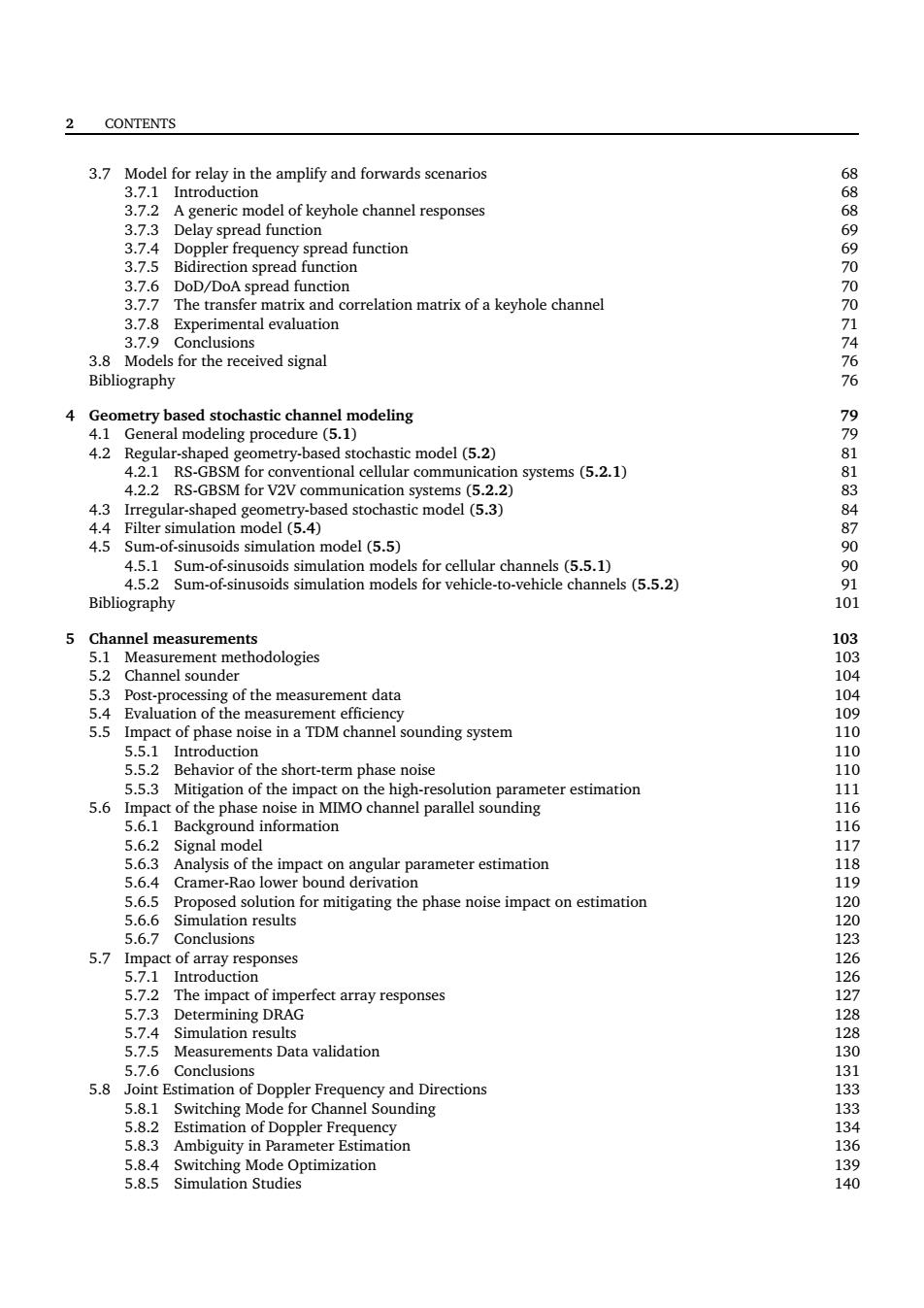
2 CONTENTS 3.7 374 ead function 3.7.5 379 elation matrix of a keyhole channel 88899000TRR aphy tic model (5.2) 42 RS-CBSM for V2V communication yems (52.2) n systems(5.2.1) 77888880090 Sum-o hicle channels(5.5.2) phy 5 Channel sounde 5.5.3 Mitigation of the impact on the high-resol tion parameter estimation 5.6 t of the pha 5.6.2 Signal model on 5.7 onses 57.3 009900001667192222222033 5.7.4 Simulation results mata validatio 5.8 de for Channel Sounding 58 Switching Mode Optimization Simulation Studie
2 CONTENTS 3.7 Model for relay in the amplify and forwards scenarios 68 3.7.1 Introduction 68 3.7.2 A generic model of keyhole channel responses 68 3.7.3 Delay spread function 69 3.7.4 Doppler frequency spread function 69 3.7.5 Bidirection spread function 70 3.7.6 DoD/DoA spread function 70 3.7.7 The transfer matrix and correlation matrix of a keyhole channel 70 3.7.8 Experimental evaluation 71 3.7.9 Conclusions 74 3.8 Models for the received signal 76 Bibliography 76 4 Geometry based stochastic channel modeling 79 4.1 General modeling procedure (5.1) 79 4.2 Regular-shaped geometry-based stochastic model (5.2) 81 4.2.1 RS-GBSM for conventional cellular communication systems (5.2.1) 81 4.2.2 RS-GBSM for V2V communication systems (5.2.2) 83 4.3 Irregular-shaped geometry-based stochastic model (5.3) 84 4.4 Filter simulation model (5.4) 87 4.5 Sum-of-sinusoids simulation model (5.5) 90 4.5.1 Sum-of-sinusoids simulation models for cellular channels (5.5.1) 90 4.5.2 Sum-of-sinusoids simulation models for vehicle-to-vehicle channels (5.5.2) 91 Bibliography 101 5 Channel measurements 103 5.1 Measurement methodologies 103 5.2 Channel sounder 104 5.3 Post-processing of the measurement data 104 5.4 Evaluation of the measurement efficiency 109 5.5 Impact of phase noise in a TDM channel sounding system 110 5.5.1 Introduction 110 5.5.2 Behavior of the short-term phase noise 110 5.5.3 Mitigation of the impact on the high-resolution parameter estimation 111 5.6 Impact of the phase noise in MIMO channel parallel sounding 116 5.6.1 Background information 116 5.6.2 Signal model 117 5.6.3 Analysis of the impact on angular parameter estimation 118 5.6.4 Cramer-Rao lower bound derivation 119 5.6.5 Proposed solution for mitigating the phase noise impact on estimation 120 5.6.6 Simulation results 120 5.6.7 Conclusions 123 5.7 Impact of array responses 126 5.7.1 Introduction 126 5.7.2 The impact of imperfect array responses 127 5.7.3 Determining DRAG 128 5.7.4 Simulation results 128 5.7.5 Measurements Data validation 130 5.7.6 Conclusions 131 5.8 Joint Estimation of Doppler Frequency and Directions 133 5.8.1 Switching Mode for Channel Sounding 133 5.8.2 Estimation of Doppler Frequency 134 5.8.3 Ambiguity in Parameter Estimation 136 5.8.4 Switching Mode Optimization 139 5.8.5 Simulation Studies 140
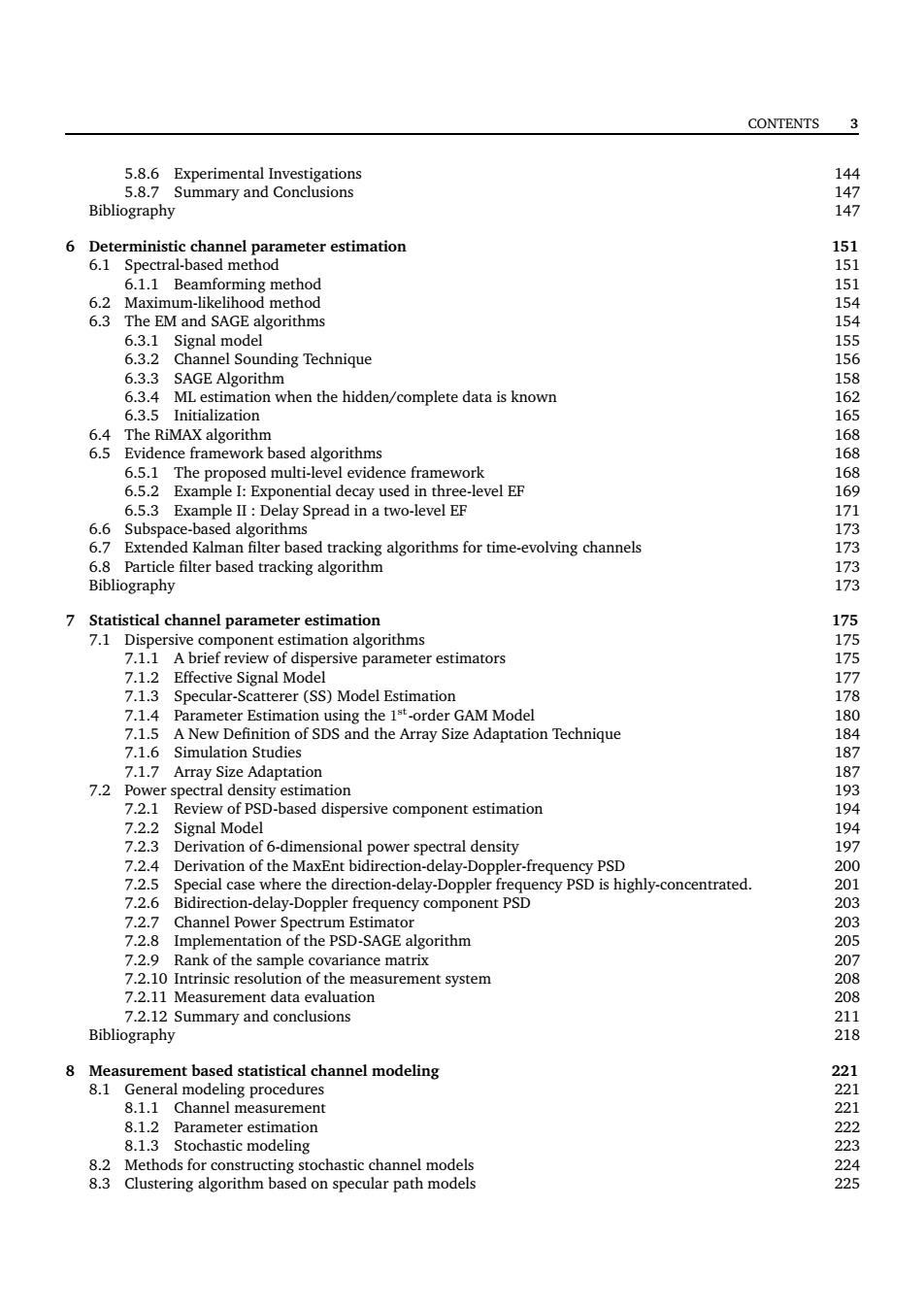
CONTENTS 3 14 Bibliography 6 th 6.2 Maximum-likelhood method 5555 6.3 555 6365Ema on when the hidden/complete data is known 6.5.2 elay Spread in a two-level EF SCage 69 6的iogpherbaseduacinggorithn 7 Statistical channel parameter esti 7.1 er estimators 7.12 Effective Signal Model erer (SS) 71.7 Simula 7704009 7.2 Po Revie of el 72.3 Derivation of 6-dimensional power spectral density 7.2.4 etraienofheaatbdieci -delay-D Bidirection-delay-Do frequen 加00 72.7 Channel Power Spectrum Estin ato tion of the PSD SAGE gorithm 720 7.2.10 Intrinsic resolution of the measurement system Measurement data evaluation 00000 Bblogap Summary an Mea nt based statistical channel modeling 8.1 General modeling procedures 812 Channel measureme 8.1.3 Stochastic modeling 2
CONTENTS 3 5.8.6 Experimental Investigations 144 5.8.7 Summary and Conclusions 147 Bibliography 147 6 Deterministic channel parameter estimation 151 6.1 Spectral-based method 151 6.1.1 Beamforming method 151 6.2 Maximum-likelihood method 154 6.3 The EM and SAGE algorithms 154 6.3.1 Signal model 155 6.3.2 Channel Sounding Technique 156 6.3.3 SAGE Algorithm 158 6.3.4 ML estimation when the hidden/complete data is known 162 6.3.5 Initialization 165 6.4 The RiMAX algorithm 168 6.5 Evidence framework based algorithms 168 6.5.1 The proposed multi-level evidence framework 168 6.5.2 Example I: Exponential decay used in three-level EF 169 6.5.3 Example II : Delay Spread in a two-level EF 171 6.6 Subspace-based algorithms 173 6.7 Extended Kalman filter based tracking algorithms for time-evolving channels 173 6.8 Particle filter based tracking algorithm 173 Bibliography 173 7 Statistical channel parameter estimation 175 7.1 Dispersive component estimation algorithms 175 7.1.1 A brief review of dispersive parameter estimators 175 7.1.2 Effective Signal Model 177 7.1.3 Specular-Scatterer (SS) Model Estimation 178 7.1.4 Parameter Estimation using the 1 st-order GAM Model 180 7.1.5 A New Definition of SDS and the Array Size Adaptation Technique 184 7.1.6 Simulation Studies 187 7.1.7 Array Size Adaptation 187 7.2 Power spectral density estimation 193 7.2.1 Review of PSD-based dispersive component estimation 194 7.2.2 Signal Model 194 7.2.3 Derivation of 6-dimensional power spectral density 197 7.2.4 Derivation of the MaxEnt bidirection-delay-Doppler-frequency PSD 200 7.2.5 Special case where the direction-delay-Doppler frequency PSD is highly-concentrated. 201 7.2.6 Bidirection-delay-Doppler frequency component PSD 203 7.2.7 Channel Power Spectrum Estimator 203 7.2.8 Implementation of the PSD-SAGE algorithm 205 7.2.9 Rank of the sample covariance matrix 207 7.2.10 Intrinsic resolution of the measurement system 208 7.2.11 Measurement data evaluation 208 7.2.12 Summary and conclusions 211 Bibliography 218 8 Measurement based statistical channel modeling 221 8.1 General modeling procedures 221 8.1.1 Channel measurement 221 8.1.2 Parameter estimation 222 8.1.3 Stochastic modeling 223 8.2 Methods for constructing stochastic channel models 224 8.3 Clustering algorithm based on specular path models 225
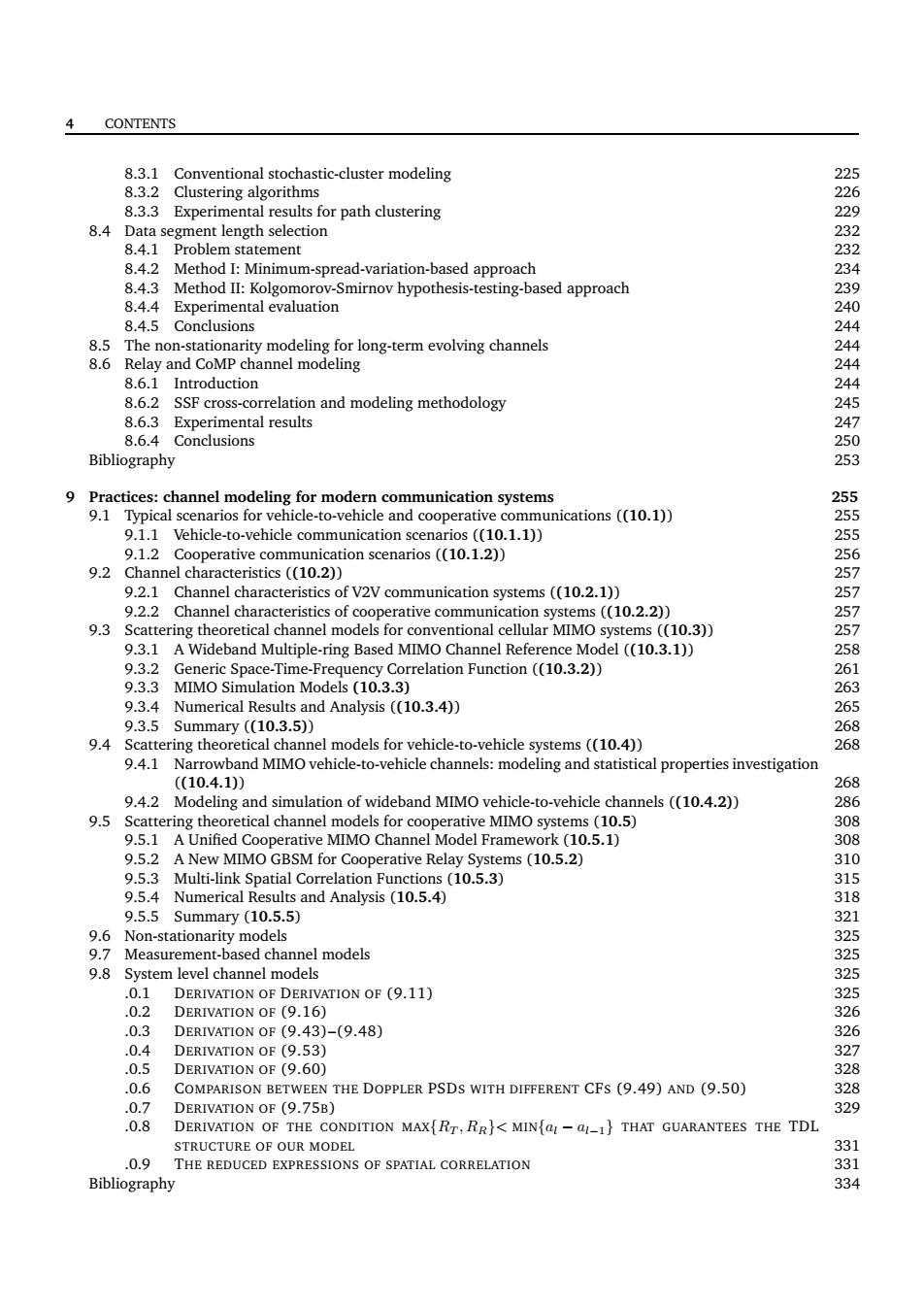
4 CONTENTS C&aneniganaaiasicdhstermodeimg 8.3.3 Experimental results for path clustering 8.4 84.2 Method I:Minimum-spread-variation-based approach 8.4.3 Method I:Kolgomorov-Smirnov hypothesis-testing-based approach 4.5 talevaluation 8.5 The non-station ity modeling for long-term evolving channels 8.6 elay and CoMP channel modeling 862 SSE CrO rrelation and modeling methodology 8.6.3 Experimental results 8.6. Conclusion ices:channel modein mmunication systems 9.1.1 Vehicle-to-vehicle communication scenarios ((10.1.1)) ications((10.1)) 9.1.2 9.2 Cooperative communication scenarios((10.1.2)) 92 ((10.2) (10.2113 9.2.2 channel chara eristics of coo erative communicat tion systems((10.2.2)) 5555 9.3 nel models for entional cellular MIMC .2 Generic Space rrelation Function 93 MIMO Simulation Models(10.3.3) 9.35 Numerical 10.3 nd Analysis ((10.3.4)) 9.Scattering theoretical channel models for vehicle-to-vehicle systems((10.)) 9.4.1 nd MIMO vehicle-to-vehicle channels:modeling and statistical properties investigation 9.4.2 Modeling and simulation of wideband MIMO vehicle-to-vehicle channels ((10.4.2)) 9.5 052 A IMO Channe .5.1 53 Multi-link Spatial Corr relation Functions (10..) 93 Summ Measurement-based channel models 325 9.8 models 0. DERIVATION OF(9.43)-(9.48) .0.6 COMPARISON BETWEEN THE DOPPLER PSDS WITH DIFFERENT CFS (9.49)AND(9.50) 328 DERIVATION OF (9.75B) 329 ITION MAX{RT,RR)<MIN(aI-a-1)THAT GUARANTEES THE TDL 3 0.9 THE REDUCED EXPRESSIONS OF SPATIAL CORRELATION Bibliography 34
4 CONTENTS 8.3.1 Conventional stochastic-cluster modeling 225 8.3.2 Clustering algorithms 226 8.3.3 Experimental results for path clustering 229 8.4 Data segment length selection 232 8.4.1 Problem statement 232 8.4.2 Method I: Minimum-spread-variation-based approach 234 8.4.3 Method II: Kolgomorov-Smirnov hypothesis-testing-based approach 239 8.4.4 Experimental evaluation 240 8.4.5 Conclusions 244 8.5 The non-stationarity modeling for long-term evolving channels 244 8.6 Relay and CoMP channel modeling 244 8.6.1 Introduction 244 8.6.2 SSF cross-correlation and modeling methodology 245 8.6.3 Experimental results 247 8.6.4 Conclusions 250 Bibliography 253 9 Practices: channel modeling for modern communication systems 255 9.1 Typical scenarios for vehicle-to-vehicle and cooperative communications ((10.1)) 255 9.1.1 Vehicle-to-vehicle communication scenarios ((10.1.1)) 255 9.1.2 Cooperative communication scenarios ((10.1.2)) 256 9.2 Channel characteristics ((10.2)) 257 9.2.1 Channel characteristics of V2V communication systems ((10.2.1)) 257 9.2.2 Channel characteristics of cooperative communication systems ((10.2.2)) 257 9.3 Scattering theoretical channel models for conventional cellular MIMO systems ((10.3)) 257 9.3.1 A Wideband Multiple-ring Based MIMO Channel Reference Model ((10.3.1)) 258 9.3.2 Generic Space-Time-Frequency Correlation Function ((10.3.2)) 261 9.3.3 MIMO Simulation Models (10.3.3) 263 9.3.4 Numerical Results and Analysis ((10.3.4)) 265 9.3.5 Summary ((10.3.5)) 268 9.4 Scattering theoretical channel models for vehicle-to-vehicle systems ((10.4)) 268 9.4.1 Narrowband MIMO vehicle-to-vehicle channels: modeling and statistical properties investigation ((10.4.1)) 268 9.4.2 Modeling and simulation of wideband MIMO vehicle-to-vehicle channels ((10.4.2)) 286 9.5 Scattering theoretical channel models for cooperative MIMO systems (10.5) 308 9.5.1 A Unified Cooperative MIMO Channel Model Framework (10.5.1) 308 9.5.2 A New MIMO GBSM for Cooperative Relay Systems (10.5.2) 310 9.5.3 Multi-link Spatial Correlation Functions (10.5.3) 315 9.5.4 Numerical Results and Analysis (10.5.4) 318 9.5.5 Summary (10.5.5) 321 9.6 Non-stationarity models 325 9.7 Measurement-based channel models 325 9.8 System level channel models 325 .0.1 DERIVATION OF DERIVATION OF (9.11) 325 .0.2 DERIVATION OF (9.16) 326 .0.3 DERIVATION OF (9.43)–(9.48) 326 .0.4 DERIVATION OF (9.53) 327 .0.5 DERIVATION OF (9.60) 328 .0.6 COMPARISON BETWEEN THE DOPPLER PSDS WITH DIFFERENT CFS (9.49) AND (9.50) 328 .0.7 DERIVATION OF (9.75B) 329 .0.8 DERIVATION OF THE CONDITION MAX{RT , RR}< MIN{al − al−1} THAT GUARANTEES THE TDL STRUCTURE OF OUR MODEL 331 .0.9 THE REDUCED EXPRESSIONS OF SPATIAL CORRELATION 331 Bibliography 334